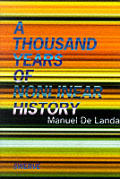[ more ]
Each assemblage is an emergent entity which can combine with others to produce ever larger assemblages; both assemblages and their component parts are thus characterised by reciprocal relations of exteriority 5. Small market towns may synthesise into regional or national markets, individuals may form social networks which in turn coalesce into organisations. But each individual or town may be involved in a wide range of assemblages, taking up differing roles in each.
The components of an assemblage can play roles which lie on a spectrum from material to expressive . All physical materials can be expressive: Take for example the characteristic spectroscopic fingerprints of different materials, as used by astronomers to identify the makeup of the universe. These expressions, much like a human fingerprint, are not functional in themselves. Deleuze regards DNA as a special instance in history where physical expressivity turned functional. Genes and words - given their functional capacities - are in his view specialised expressive entities 4. De Landa maintains however that language does not play a constituent role in social assemblages, but that it is one amongst several primary expressive materials 1.
To extend assemblage theory to the urban — the urban assemblage — is to regard the urban as the site of certain densities and concentrations of material processes which are necessarily spatial. We can conceive of these as intensities of flows along networks operating at different scales. The components of these assemblages are not only bodies, but labour, resources (food), money, buildings, infrastructure, language and a range of other materials, including those constitutive of climates.
One can choose the individual as the smallest component in this ontology, but here a crucial distinction must be made with traditional sociology. The individual mind - Latour’s actor in actor-network theory - is considered a physical assemblage. As a material component like any other, it is not the core element in social assemblages. This allows us to free assemblages from their representation as a collection of subjects, moving us towards an object-oriented ontological framework 6. In this framework subjectivity itself emerges as an assemblage, it has no privileged position.
This ontology is opposed to any form of taxonomic essentialism, which entails a supposition that categories can refer to things in the real world, and in doing so moves us towards the notion of a mind-independent reality. As De Landa puts it,
"The ontological status of any assemblage, inorganic, organic or social, is that of a unique, singular, historically contingent, individual... Much as biological species are not general categories of which animal and plant organisms are members but larger-scale individual entities of which organisms are component parts, so social assemblages should be given the ontological status of individual entities: individual networks and coalitions; individual organisations and governments; individual cities and nation states. This ontological manoeuvre allows to assert that these individual entities have an objective existence independently of our minds." 2
This approach can be seen as a form of materialism in which matter 7 and energy take precedence over discourse and ideology. Human culture can thus be interpreted and analysed as a history of material flows - linguistic, economic, genomic - forming a kind of geological strata over time, observable as material histories subject to morphogenetic processes 3. From this perspective the social has a material being all of its own.
The dynamics and structural properties of social assemblages - their growth, topologies, characteristic intensities, relations of exteriority, and interactions, can thus become the object of social science. Assemblages, unlike totalities, are analysable because they can be reconstructed from their constituent parts. In order to do this one must understand the relations that characterise the assemblage in terms of its emergence as a result of the dynamic interactions of its components. This does not entail the reduction of a totality, as to explain “the mechanisms of emergence does not explain emergence away…” (Mario Bunge).
Network theory provides us with a representational toolkit for examining urban assemblages, whilst complexity science gives us a mathematical framework for dealing with emergence. Computer models can help us to understand how different synthetic processes involving differing components can produce assemblages with differing characteristic identities. These tools allow us to pursue a social science methodology based on assemblage theory.
See Also: Emergence, Network, Morphogenesis
- 1 Manuel De Landa, A New Philosophy of Society - Assemblage Theory & Social Complexity, Continuum (2006)
- 2 Manuel De Landa, A New Philosophy of Society - Assemblage Theory & Social Complexity, page 40, Continuum (2006)
- 3 Manuel De Landa, A Thousand Years of Non-Linear History, MIT (2002)
- 4 Gilles Deleuze, A Thousand Plateaus, Continuum (2003)
- 5 Adrian Parr (ed), The Deleuze Dictionary, Columbia University Press (2006)
- 6 Object-Oriented Ontology Symposium, Georgia Tech school of literature, communication and culture (2010)
- 7 Uniformity & Variability: An Essay in the Philosophy of Matter, Manuel De Landa (1995)
 A Thousand Years of Non-Linear History · Manuel De Landa (2002)
A Thousand Years of Non-Linear History · Manuel De Landa (2002)